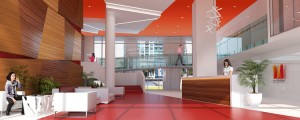Stephan Gietl and Fernando Levy Hara, two friends from very different parts of the world who now live mostly in Miami, first met at Harvard graduate school, where they decided to make a joint venture buying distressed assets. They called their business McKafka, and it quickly became a very successful pioneer on the Miami scene. Gietl is the Chief Financial Officer of McKafka, and works on the legal side of development, while Hara is Chief Executive Officer.
Their latest work, Crimson, is in the Edgewater neighborhood. Hara says of Edgewater that it’s “the new neighborhood in Miami, where you see the new mood of real estate.” The neighborhood is full of young people. There is a shorter commute than from the suburbs, along with all the other benefits of city life: restaurants, coffee shops, the ‘Metro-Mover’ monorail, and beach front living. The neighborhood is very environmentally conscious. According to Gietl, some of Edgewater’s popularity comes from its proximity to the design district, a location that has picked up in the last 3-5 years. “We are seeing movement of the ultra-luxury brands […] from Bell Harbor to the design district.” And, “The growth in the city is currently going north, along [highway] 195.”
Crimson was designed for young people from the beginning. The approximate market is 25-35. There are a lot of amenities designed to appeal to people in that age group or who live with roommates. There is a cyber Café for using computers. As Hara says, “One [roommate] may want to study [at the cyber Café], and one may want to play guitar.” There is also a business center for young professionals which can be booked at no cost. It can be used as an office for meeting clients. There are also the usual ultra-luxury amenities such as a gym, movie theater and pool deck. “Everybody who is buying now is foreign investors,” Hara said, “So we design the units […] to be a medium size because this makes a better profit for investors.” The building was designed with special energy efficient, environmentally healthy features to keep maintenance costs down for investors, such as the VRF air conditioning system. They wanted to keep both the residents and the investors in mind. Units on the water start at 300 thousand, whereas similar units elsewhere in Edgewater start at half a million or 600 thousand. Other buildings may have 200 or 300 units, but the Crimson has just 90. The atmosphere of the Crimson is therefore described by Hara as “a boutique-style building where everybody knows everybody.”
In terms of green, environmentally friendly features, McKafka focused on energy efficiency. The VRF cooling system comes from Japan, and the company chose it over others of comparable size because the electricity consumption is much lower, and there is a much lower noise level. There is a system that separates recyclable garbage from other waste. There are also electric car chargers in the garage. “We anticipate a lot of owners will decided to have electric cars in the next ten years,” says Gietl. Too much glass means excess energy consumption, so Hara says “We designed the building […] with a good division between glass and walls.” The company was inspected by LEED certifiers during construction to ensure they were operating a green construction site. “We believe in a better environment, and contributing to make Miami a sustainable city,” says Hara.
There is a joint park between Related and Crimson. It will be around 20,000 square feet, and gated in the evening for security. It is accessible to everyone during the day, but is a private park at night. There is a fountain that purifies water.
McKafka has recently bought more distressed properties from 2009 to 2012. They are also working on a 90 unit building next to the airport, with many airplane attendants and pilots for renters.



